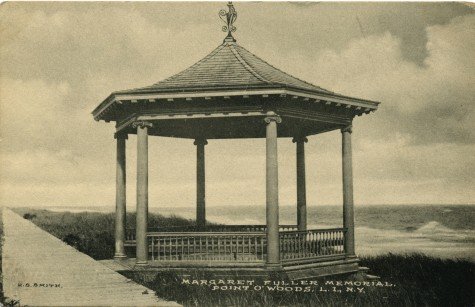By Thomas McGannThis year marks the 165th anniversary of the shipwreck of the barque “Elizabeth” off the coast of Fire Island. On July 19, 1850, a sailing vessel named “Elizabeth” ran aground on a bar near Point O’ Woods, five miles east of the present day Fire Island Lighthouse. Eight persons died in that tragedy including the renowned author and feminist Margaret Fuller, her Italian revolutionary husband and their child. This event was the catalyst for the construction of the present day Fire Island Lighthouse, the presence of which has prevented many subsequent tragedies.Women’s RightsMargaret Fuller was an early women’s rights advocate, a believer in prison reform, as well as an abolitionist. She embraced the Transcendentalist movement that was popular in the early 1800s, believing in the goodness of man and nature, and that society and its institutions, such as religion and politics, corrupted man’s soul.She was the author of “Women in the Nineteenth Century,” the first major American feminist tract. Other feminists of her generation such as Susan B. Anthony and Elizabeth Cady Stanton credit Fuller, writing that she “was the precursor of the Women’s Rights Agitation.”She also worked for Horace Greeley at the New York Tribune as its first full-time book critic of either sex, and then as its first female editor. In 1846, Greeley sent Fuller to Europe as his first female foreign correspondent.An Italian RevolutionaryIn England, Fuller met Giuseppe Mazzini, an Italian revolutionary responsible, with Giuseppe Garibaldi, for unifying Italy. Fuller also met Giovanni Ossoli, one of Mazzini’s lieutenants, a man 10 years her junior, with whom she conducted a passionate love affair resulting in the birth of their child, Angelino.In 1848, Ossoli fought with Mazzini to establish a Roman Republic, a unified Italy. This particular Italian revolution was short lived however. The Austrians quickly dispatched Mazzini and his cohorts, forcing them into exile.Ossoli was penniless and on the run with his wife and child. They decided to transit to America where Fuller intended to publish her history of the Italian Revolution. They booked passage on the “Elizabeth,” a 530-ton barque, carrying a cargo of mostly Carrara marble. Prior to embarking, Fuller wrote to a friend, “various omens have combined to give me a dark feeling … that my future on earth will soon close … I have a vague expectation of some crisis — know not what.”Shipwreck of the “Elizabeth”On May 17, 1850, the “Elizabeth” left Leghorn, Italy, enroute New York, carrying five passengers and a crew of 14 under Captain Seth Hasty. The ship was barely a week at sea when the captain came down with small pox and died soon thereafter. The first mate, one Mr. Bangs, a man of limited experience, assumed command.After transiting the Atlantic, on July 18, the “Elizabeth” lay just off New York, ready to make port the following day when a fierce gale blew down on her. Faulty navigation by the inexperienced captain had placed the “Elizabeth” too close to shore, and at about 3:30 a.m. on July 19, the ship struck a bar broadside. The cargo smashed through the hull flooding the hold. The ship foundered some 200 yards offshore as rain and gale-driven waves swept her decks.On shore, the U.S. Life Saving Service arrived equipped with a lifeboat and a line-throwing mortar. They were unable to launch the lifeboat due to the heavy seas, and the gale winds, blowing shoreward, prevented all lines fired by their Lyle gun from reaching the deck of the stricken ship.Sometime later, a large wave lifted the ship, smashing her into two on the bar. Somehow, all the crew and passengers survived, gathering on the forecastle, the only part of the ship still above water. With rescue from ashore now impossible, those on shore watched those on the ship with a quiet desperation. The ship was so close to shore that, with but a score or so of oar strokes, a lifeboat could have saved them all, but that lifeboat could not be launched.Captain Bangs gave the order for all hands to save themselves. Several of the crew then jumped into the sea, leaving the rest to fend for themselves.Giovanni Ossoli did not know how to swim, so the three family members clung to each other, trapped, resigned to their deaths. In a desperate attempt to save the child, the ship’s steward snatched the baby from Margaret’s arms and leapt into the sea.Another wave crashed down onto the hull cracking the ship’s mast in two, throwing everyone remaining onboard into the sea.The AftermathEight persons perished in the disaster. The ship’s steward and the baby both drowned and their bodies were later recovered. The bodies of Margaret Fuller and Giovanni Ossoli, however, were not found.Henry David Thoreau, the writer and naturalist famous for his book “Walden,” and his friend Ralph Waldo Emerson, the famous essayist and poet, were both fellow transcendentalists and good friends of Fuller’s. Thoreau went to Fire Island at Emerson’s urging to see if he could find the bodies of Fuller and her husband.According to Joan von Mehren in her book “Minerva and the Muse,” Thoreau cut a sad, solitary figure as he walked up and down the barrier beach searching for their bodies. He was unsuccessful. Fuller’s manuscript was lost as well.Emerson subsequently published a best-selling memoir of Fuller that focused on her individuality and her personal life (including her affairs) instead of on her work, for which he was widely criticized.In 1901, Julia Ward Howe had a memorial to Fuller placed on the beach near where the wreck had occurred, that too was taken by the ocean some 10 years later.The uproar caused by the wreck of the “Elizabeth”, and the death of Margaret Fuller and her family, spurred on by her high-powered friends, resulted in Congress allocating monies for a new, improved lighthouse.This present-day lighthouse stands 168 feet tall, powered by two 1000-watt bulbs, flashing every 7.5 seconds. It has a visibility of 21-24 miles. Between the years 1640 to 1825, there were more than 400 ships reported in distress off Fire Island, but since the completion of the new lighthouse this number of has been drastically reduced — thanks to a women’s rights advocate, an Italian revolutionary and the unfortunate shipwreck of the barque “Elizabeth.”
































